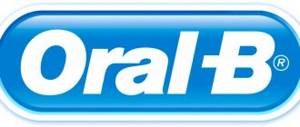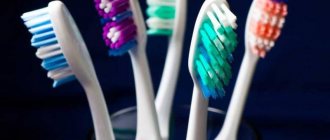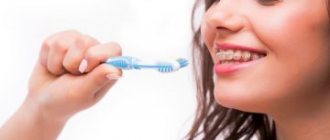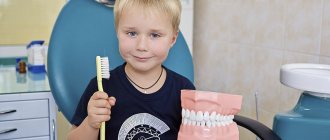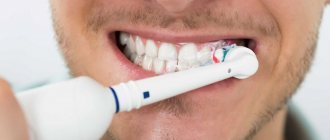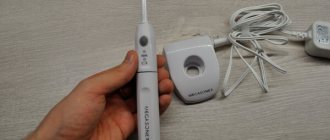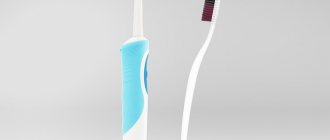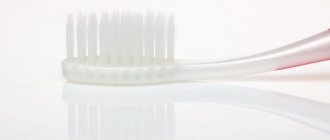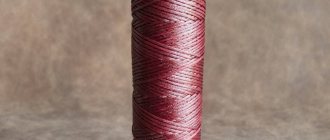Before answering this question that our clients ask us, let me turn to the history of the creation of these hygienic devices. This will help you find the answer even without expert advice.
No one can say for sure when the toothbrush first appeared. Even ancient people had a need to clean their teeth; for this they used bunches of grass and crushed plant branches. In Ancient Egypt, teeth were cleaned with ash. Several thousand years ago, Chinese nobles acquired special devices reminiscent of modern toothbrushes. Both the brushes themselves and the cleaning products improved over time, and in the 20th century, electric toothbrushes appeared, which, it seemed, would finally solve the problem of destroying plaque.
In 1955, the American dentist Gerard Moyer drew attention to the fact that his clients had dental problems (caries, periodontal disease) despite the fact that these people regularly brushed their teeth with the most modern means at that time and followed the recommendations of dentists. After carefully analyzing the nature of the diseases and identifying the foci of their occurrence, Moyer came to the conclusion that classical brushing of the oral cavity with a toothbrush cannot guarantee complete removal of plaque. Even after the most thorough cleaning, there were areas of the oral cavity on which persistent plaque formed, which became the cause of the disease. Therefore, additional exposure to these areas was required. Thus was born the idea of creating a device that could generate a water stream under pressure, which, penetrating into these hard-to-reach areas, washed away the remaining plaque. The device was created already in 1958, called an “oral irrigator” and was designed to complement the procedure of regular toothbrush cleaning with effective irrigation, providing the highest level of hygienic protection. So, the creators of the irrigator themselves answered the question “irrigator or brush”: “both irrigator and brush.”
Irrigator
Purpose
Despite the fact that this instrument for cleaning the oral cavity was invented in the middle of the last century, it is still not widely popular among us. But in vain, because it helps to thoroughly clean the spaces between the teeth, which a toothbrush cannot reach. In addition, it removes plaque and food debris, preventing the formation of tartar. This partially solves the issue of gum health. Massage, which is performed using a stream of water or medicinal liquid, makes them stronger.
Using the device, they clean the tongue, penetrate into the gum pockets, removing food debris and bacteria accumulated there. Its use is especially indicated for people who have bridges, crowns, removable structures and braces installed.
Home whitening products (whitening pastes and strips)
Of course, these products give us an aesthetically pleasing effect. How is it achieved? Under the influence of a certain reaction, we displace pigment from the crystal lattice of the enamel and fill it with oxygen.
Important : after this procedure, hypersensitivity and small lumbago may occur. This indicates that the tubules inside the tooth are slightly spasmed.
In addition, when you do such a procedure, you need to know certain “rules of conduct” after bleaching and strictly follow them (for example, do not drink coloring drinks) in order to preserve the result of the work as long as possible. It is also not recommended to bleach more than twice a year.
An electric toothbrush
Purpose
Typically, an electric toothbrush consists of a housing in which a motor is built. It is powered by a battery or accumulator. An electric brush is more effective than a mechanical one in removing plaque, which is formed by bacteria on the surface of tooth enamel. Its rotating head is equipped with dense bristles that destroy the film formed by them.
Toothpaste helps them with this. Usually it contains useful substances, microelements, and medicinal compounds. They strengthen the enamel, returning its whiteness and brightness. The bristles of such a brush can move in different directions, up and down, or in a circle.
There are several types of electric toothbrushes on sale:
- Sonic cleans the surface of teeth, prevents the formation of stones
- Ultrasonic devices operate silently, remove pigmented plaque, and promote the penetration of cleaning paste into the tissues of the oral cavity.
Therefore, before purchasing a brush, it is better to consult your dentist. What all models have in common is that it is not recommended to make translational movements near the gums. This can cause damage to the enamel.
TOP 7 Best electric toothbrushes with irrigator
Pros and cons of an electric toothbrush
Advantages:
- Cleans the surface of teeth efficiently
- Remove plaque
- Whiten enamel
Flaws:
- Use may cause teeth to become loose
- If used incorrectly, it provokes separation of enamel from the gums.
- Increases sensitivity
- It is necessary to change the nozzles approximately every 3-4 months
Dental floss
Of course, floss should exist in every person's life to prevent the occurrence of caries between teeth. But with an incorrect bite, crowded teeth, poor-quality restorations, etc. its use is often made problematic.
Important : use dental floss so that it does not injure the gingival papilla, which may begin to bleed. If that doesn’t work, then it’s better to use an irrigator.
Article on the topic
TEST: Is the dentist waiting for you?
Is a portable irrigator a substitute for an electric toothbrush?
A portable irrigator cannot replace either an electric or a manual toothbrush, because these devices perform different functions. An electric brush is a primary hygiene item, and an irrigator is a secondary item. An electric brush cannot fully clean the spaces between the teeth, treat the tongue, and gum pockets, where it often drives microorganisms.
It cannot provide hydromassage of the gums, which serves as a prevention of bleeding, periodontal disease, and inflammatory processes. The highest quality electric brush cannot clean braces as well and carefully as a pulsating stream of water from an irrigator will do.
An electric brush is used to clean the surface of the teeth, and an irrigator is used to treat hard-to-reach areas between them, near crowns, and under braces. It also performs a strengthening hydromassage of the gums using pulsating water jets, providing the ideal frequency for the oral cavity.
What's better?
Dentists do not recommend completely replacing traditional dental floss with an oral irrigator. A water flosser is great at removing food particles and superficially rinsing away plaque with a pressurized water jet, but it can't replicate the scraping motion of dental floss that thoroughly removes plaque that can eventually cause gum disease. For optimal oral hygiene, it is recommended to use both traditional dental floss and a water flosser.
However, in some cases, using an oral irrigator is preferable to dental floss:
- Sensitive gums. Brushing your teeth with an oral irrigator is less painful, which is important for people with sensitive gums.
- Braces. Using a water flosser under pressure is one of the best ways to clean food particles from your braces without using traditional dental floss.
- Problems with fine motor skills. A water flosser can be especially helpful for people with arthritis or braces who have difficulty flossing.
In such cases, when flossing is difficult or impossible, an oral irrigator will come to the rescue.
How to use a irrigator to care for braces?
- connect the device to the power supply,
- fill the container with warm boiled or filtered water. You can add antiseptics or mouth rinses to it. Wait for the special signal
- install the desired nozzle on the hose,
- select a certain water pressure - it is better, of course, to start with the minimum, gradually increasing it,
- direct the flow of water to problem areas at an angle of the nozzle of about 45 degrees, move it along the entire dentition and do not forget about the gums - they also need care,
- After use, remove any remaining water from the container and turn off the device.
After using the device, do not forget to rinse it and rinse it with water. It is necessary to use irrigators, if possible, at least 2 times a day: in the morning and in the evening. As a last resort - only in the evening before bed.
Instructions for use
Before you start using the irrigator, you need to check it. The container is filled with boiled warm water, and all the liquid is released in a continuous stream.
If everything is normal with the operation of the device, water is prepared for it or it is connected to the water supply. After this, the device is ready for use.
When first used, the jet pressure should be kept small, especially with inflamed gums. During the cleaning process, it can be increased if no discomfort occurs.
The general cleaning procedure is as follows.
- A person leans over the sink, opens his mouth slightly so that water can flow freely, turns on the irrigator and directs the stream to the braces.
- Cleaning begins from the distal sections, gradually moving to the front.
- First, the clasps are cleaned, then the gum line, and finally the interdental space.
- After all the locks have been passed, the jet is directed to the remaining areas of the oral cavity.
- The procedure ends with a massage of the gums using a massage attachment.
The device must be used in strict accordance with the instructions; the stream must not be directed into the nose, ears, or eyes.
After cleaning, all used attachments must be dried and stored in their compartments. If the battery or batteries are discharged, the first one must be charged, and the batteries must be replaced.
In the video, a specialist explains how to use the irrigator correctly.
Price issue
Like the cost of any medical devices, the price of an irrigator depends on the brand, type, functionality and configuration. The pharmaceutical market offers a huge number of models:
- The cheapest are mechanical. Their price is only a few hundred.
- The next ones are flow-through irrigators with a price starting from 2000 rubles.
- Portable devices are more expensive than flow-through devices; their price starts from 3,000 rubles.
- The most expensive are stationary models, the price of which varies from 3 to 6 thousand rubles. and more.
Before purchasing, it would be a good idea to find out whether the purchased model is serviced in the city. This is especially important if you buy an expensive device.
Reviews
Careful care of braces guarantees the absence of problems after treatment in the form of demineralization of enamel, incipient or severe caries. Unfortunately, this is not such a rare occurrence, since braces significantly worsen dental care conditions.
We are interested in any opinion regarding the use of irrigators. Especially if you had the opportunity to compare the quality of cleaning braces with and without an irrigator. The comment form is at the bottom of this page.
If you find an error, please select a piece of text and press Ctrl+Enter.
Tags braces care for braces
Did you like the article? stay tuned
No comments yet
Attachments for cleaning bracket systems
The following types of attachments are suitable for effective cleaning of braces:
- Orthodontic attachment OD-100E. Designed for thorough and gentle cleaning of braces and other orthodontic systems. Delivers a thin stream of water for spot treatment of all elements. Removes food particles and soft plaque well, recommended for everyday individual use.
- Nozzle for removing plaque PS-100E. Equipped with three tufts of soft bristles that thoroughly remove bacterial deposits and wash them away. To increase cleaning efficiency, when using the nozzle, you need to use movements like when brushing with a toothbrush. Regular use of the nozzle allows you to remove plaque from teeth and gums and clean orthodontic and orthopedic structures.
- Periodontal tips PP-100E and PP-70E. Designed to care for deep gum pockets, but no less effective when cleaning braces. Allows you to effectively clean even hard-to-reach places.
Nozzles must be changed every 3 months.
Which irrigator to buy for braces:
- Waterpik WP-100 E2 Ultra, WP-108 E2 Ultra Gold, WP-112 E2 Ultra Black.
- Waterpik WP-300 E2 Traveler.
- Waterpik WP-450 E2 Cordless Plus, WP-462 E2 Cordless Plus Black, WP-560 EU Cordless Advanced.
- Waterpik WP-660 E2 Ultra Professional, WP-672 E2 Ultra Professional Designer Series.
- Waterpik WP-260 E2 For kids.
According to reviews from dentists and buyers, the leaders are stationary models with a large reservoir for medical solutions, in particular, Waterpik WP-100 E2 Ultra. Stationary irrigators come with up to 7 attachments, including a special attachment for caring for orthodontic systems.
Irrigators for caring for braces: types
An irrigator is a device that supplies liquid under a certain pressure - through a nozzle it can be used to clean teeth, braces, and even massage the gums. Irrigators are completely safe for braces; they do not damage structural elements, but clean them incredibly thoroughly.
There are several types of irrigators on the market today. Depending on the conditions in which it will be used, you can choose the most optimal option for yourself:
- stationary irrigators: the device connects to an electrical outlet, allows you to adjust the water pressure, has a large container for liquid, or connects to a water tap. The set includes several different attachments. This is the optimal device for home use. Among the main disadvantages are the massive size,
- portable or travel irrigators: compact, small devices that are powered by a battery or batteries. This device is more mobile, which allows you to take it with you on the road. Due to the small power source, the device is not able to create high jet pressure, which means it is less effective. It also has a small supply of liquid and battery power.
Suggested Modes
The pressure (flow rate), composition and nature of water supply in irrigators may change. Depending on them, the following modes are used:
- Standard. The stream of water flows continuously, without changing its speed. The mode provides good washing of exposed surfaces, but does not do a good enough job of cleaning the components of brackets with a complex configuration.
- Throbbing. Water supply is intermittent. Fast micro-impacts, with a frequency of 1400-1800 times per minute, break up pieces of food and ensure thorough cleaning of braces
- Microbubble. Water is mixed with air, and an air-water mixture is supplied to the braces.
When hitting a surface, the bubbles “explode”, creating increased cleaning energy. It is enough even to remove soft plaque. In addition, studies have shown that microbubble cleaning has a certain bactericidal effect.

